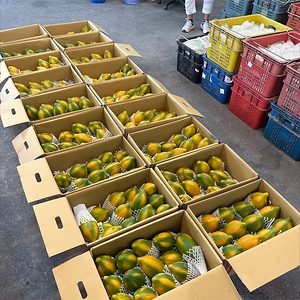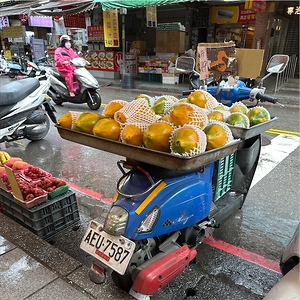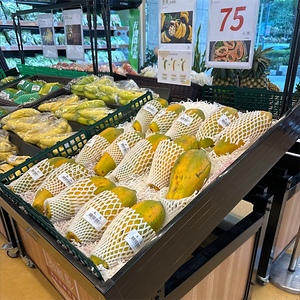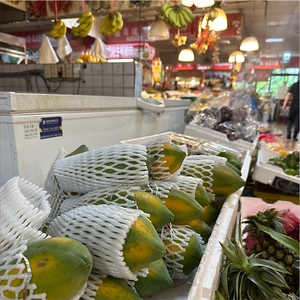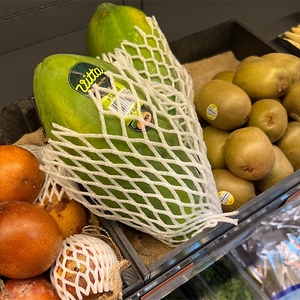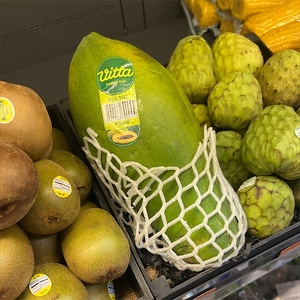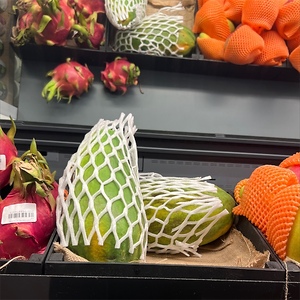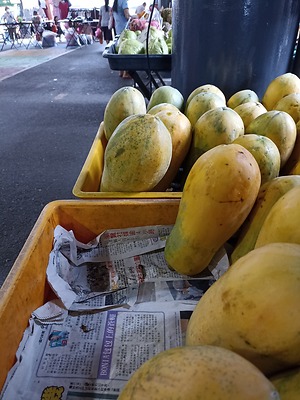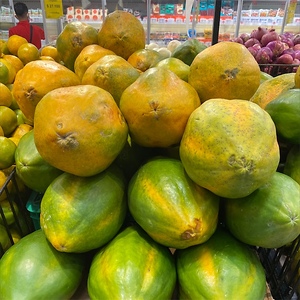


Tainung Papaya
Estimated Inventory, lb : 0
Description/Taste
Tainung papayas vary in size and shape, depending on cultivation methods, variety, and age at harvest, but generally have an elongated, cylindrical, and tapered shape with one blunt end and one pointed end. The fruits average 8 to 9 centimeters in diameter and 20 to 22 centimeters in length, and the skin is firm, smooth, taut, waxy, and lightly ridged. Tainung papayas ripen from green to shades of golden yellow-orange. Some Tainung varieties will not transition completely into yellow hues and may showcase patches or striping of muted green, even when ready for consumption. Underneath the surface, Tainung papayas showcase red-orange flesh with a central cavity filled with small, hard, black, round to oval seeds. When young, the flesh is firm, dense, lightly aqueous, and crunchy, with a crisp, almost carrot-like consistency. If the flesh ripens, it will become soft, aqueous, tender, and succulent with a high water content. Tainung papayas should feel heavy, give slightly when pressed, and be at least 50% yellow when ripe. The flesh has an aromatic scent and a rich, sweet, tropical, floral, and musky flavor, ranging from 11 to 12 degrees Brix, a sugar measurement. The seeds have a peppery, warm, and pungent taste.
Seasons/Availability
Tainung papayas are available year-round, with a peak season from July through November.
Current Facts
Tainung papayas, botanically classified as Carica papaya, are a category of varieties developed in Taiwan, belonging to the Caricaceae family. Tainung varieties were developed by Taiwanese agricultural breeding programs in the late 20th century and were selectively bred for improved characteristics to increase cultivation. Each Tainung cultivar is labeled with a breeding number, and eleven varieties have been released, numbering from 1 to 11. Tainung No. 2 is the most successful variety of Tainung papayas, accounting for over ninety percent of Taiwan’s papaya production. The variety featured in the photograph above is Tainung No. 2, which is favored for its high yields, extended production period, orange-red flesh coloring, smooth texture, and sweet, tropical taste. Tainung papayas, also written as Tainong, are widely found in fresh markets across Taiwan and are often nicknamed a “longevity fruit” for their nutritional properties. The fruits are versatile in culinary preparations and are consumed in a wide array of sweet or savory dishes and beverages. It is important to note that Tainung papaya varieties may vary in flavor as each is distinct from the other cultivars, and their flavor and texture will change throughout the year, depending on the season and weather. Summer and fall are the preferred seasons, as the summer temperatures allow the plants to produce high yields while the fall produces the sweetest fruits.
Nutritional Value
Tainung papayas vary in vitamin and mineral content, depending on the specific variety. Papayas, in general, are a source of fiber to regulate the digestive tract, vitamin E to guard the cells against free radical damage, vitamin A to maintain healthy organ functioning, and vitamin C to strengthen the immune system. Papayas also provide calcium to support bones and teeth, potassium to balance fluid levels within the body, iron to develop the protein hemoglobin for oxygen transport through the bloodstream, phosphorus to repair tissues, and other nutrients, including vitamin D and B vitamins. The fruits are high in papain, a natural enzyme that improves digestion. The orange-red coloring of the flesh indicates the presence of lycopene, an organic pigment known as a carotenoid with antioxidant properties to help reduce inflammation.
Applications
Tainung papayas have a sweet, tropical, and musky flavor suited for fresh and cooked preparations. Tainung varieties are traditionally consumed out of hand, but Tainung No. 2 is the most common cultivar consumed for culinary purposes. The fruits should be washed and opened, the seeds removed, and the flesh sprinkled with lime juice or chili powder for enhanced flavoring. The flesh can also be eaten with cottage cheese, tossed into salads, or served as a fresh topping over parfaits, fruit bowls, and other breakfast dishes. In addition to eating the flesh raw, Tainung papayas can be blended into smoothies, juices, and shakes. They can also be pureed into dressings and sauces. In Taiwan, papayas are popularly used in stewed pork ribs. They are also consumed in their green state and shredded into chilled salads, fried into savory cakes, or simmered into soups. Beyond savory preparations, Tainung papayas are cooked into jams or baked into pies, cookies, and shortbread. Papaya seeds are also edible and have a peppery taste. The seeds can be dried and ground into a spice, used in place of black pepper, or added to salad dressings. Tainung papayas pair well with herbs such as lemongrass, cilantro, and mint, fruits such as pineapples, passion fruit, mango, bananas, citrus, and coconut, peanuts, and meats such as poultry, beef, or pork. Whole, unopened green papayas should be ripened at room temperature. Once ripe and ready to eat, Tainung papayas will keep in the refrigerator for up to five days.
Ethnic/Cultural Info
Tainung papayas are famously used in papaya milk, one of Taiwan’s national drinks. Papaya milk and bubble tea are the country’s two most well-known beverages, and while bubble tea has recently increased in notoriety worldwide, papaya milk is a traditional drink dating back to the mid-20th century. Papayas are grown year-round in Taiwan, and new varieties were extensively bred in the mid-20th century for improved flavor. Growers quickly adopted these varieties across Taiwan, and papaya became a staple, everyday fruit. Around the same time, the milk industry was also advancing. Ice and chilled dessert shops began combining milk and fruits for various sweet dishes across Taiwan, and sometime before the 1950s, papaya milk was born. It is unknown who first created the creamy, fruity drink, but it became a favored recipe among night market vendors, ice cream shops, and juice stores. Papaya milk is a mixture of blended papaya juice, milk, sugar, and ice and is a favored beverage consumed during the hot summer months. The drink is widely available across Taiwan, and there are even street vendors who sell the drink solely as a source of income. Despite its popularity in the island country, papaya milk is relatively unknown and an uncommon beverage to the rest of the world. It is important to note that papaya milk has a relatively short shelf life when made fresh and will begin to change in consistency and flavor within an hour of preparation. Papaya milk should be enjoyed immediately for the best quality and taste.
Geography/History
Tainung papayas are native to Taiwan and are descendants of varieties introduced from the New World. Papayas, in general, have roots in the Americas and have been growing naturally since ancient times. The center of origin for the wild species is thought to have been in the lowlands spanning from Mexico to Panama. Seeds of the species could be stored for several years once dried, and these seeds were eventually carried from the Americas to the Caribbean, Europe, and Southeast Asia by Spanish and Portuguese explorers around the 16th century. Papayas were introduced to Taiwan from China sometime during the Qing Dynasty, from 1644 to 1912 CE. For several years after their arrival on the island, papayas remained a low-cultivated crop due to varieties unsuitable for Taiwan’s climate. Beginning in the 1940s, the Agricultural Experimental Institute’s Fengshan Branch started importing new papaya varieties and began breeding improved cultivars suited for Taiwan's tropical and subtropical regions. In the 1960s, Tainung No. 1 was officially bred, followed by Tainung No. 2 and Tainung No. 3 in the 1970s and 80s. Tainung No. 2 was created from a cross between a Risheng and a Thai variety and later became the dominant cultivar in Taiwan. Tainung varieties significantly altered Taiwan’s papaya industry, and the fruit became one of the most popular fruits sold for everyday purposes. Today, many varieties of Tainung papayas are identified by breeding numbers. These varieties are grown throughout Taiwan, primarily in Chiayi, Tainan, Pingtung, Kaohsiung, Yunlin, and Nantou counties. Tainung papayas are sold fresh in commercial markets, and select varieties are exported to China, Japan, Singapore, Hong Kong, Brazil, and the United States. The Tainung papayas featured in the photograph above were sourced through the First Fruit and Vegetable Wholesale Market in Taipei, Taiwan.



